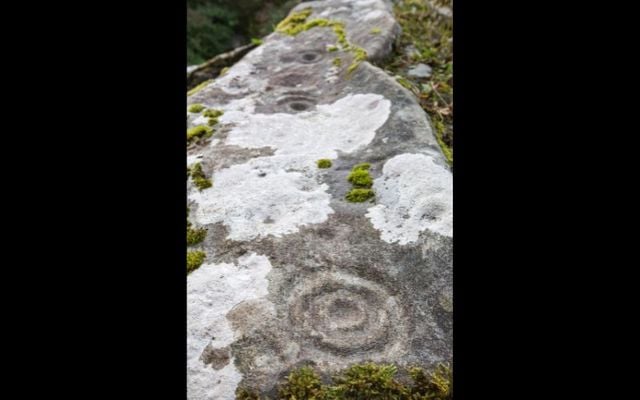The Boheh Stone, also known as St. Patrick's Chair, is an example of Neolithic rock art that is the viewing point for a spectacular sight twice a year.
On April 18 and August 24, a phenomenon in which the sun appears to 'roll' down the north-western flank of Croagh Patrick can be viewed from the Boheh Stone, if the weather conditions are favorable.
The Boheh Stone is positioned on a natural rocky outcrop located on the Eastern slope of Croagh Patrick close to the village of Brackloon, not far from Westport, in Co Mayo.
The stone, which dates from between 4000 and 2500 BC, is profusely carved with over 250 Neolithic “cup and ring” motifs covering virtually its entire area. The intricate designs are a remarkable example of prehistoric art which flourished in Neolithic Ireland with similar examples evident at the passage tombs of Knowth, Dowth, and Newgrange.
Mountains, especially of the conical variety, were extremely important to the ancient Irish and moreover Croagh Patrick was believed to the domain of Lugh the Celtic sun God.
The discovery of the “Rolling Sun”
Historian Gerry Bracken is credited with rediscovering the Boheh Stone in 1981.
In 1996, he wrote about his discovery: "I first saw it in 1981, when making a list of antiquities in the Westport area. There is indeed a rough 'chair' on one side, but what caught my attention in the glancing sunlight that evening was the many concentric circles etched into the sloping faces of the outcrop, and all over the flat top. Faded from weathering, I realised this rock art pre-dated St. Patrick's arrival in the West of Ireland by at least two thousand years.
"Although now surrounded by high hedges, the Boheh Rock originally commanded an unrestricted view to the west, dominated by the striking pyramid-mountain of Croagh Patrick.
"Intrigued by this enigma, I began a study of 'Cup and Ring' motifs in an effort to understand why this rock was selected for such elaborate treatment. I learned that while this art form is also found in the north-west and south-west of Ireland, St. Patrick's Chair is the sole example known west of the Shannon. It is also the most comprehensively worked example in Ireland."
Bracken wrote that he was determined to figure out the significance of the Boheh Stone and whether or not there was a "solar connection," as there is with the world-famous Newgrange.
"Over the next few years, I observed sunsets at the solstices and equinoxes but found nothing significant," Bracken wrote.
"There was but one major alignment that still eluded me - the date of sunset on the peak of Croagh Patrick. This striking mountain creates its own weather system, and cloud frequently obscures the sun when it sets in its vicinity.
"But I persevered and eventually succeeded in confirming that the sun sets on this lovely peak twice each year - on 18th April and on 24th August.
"What I did not expect to see, however, was that the sun, having set on the summit, then appears to roll down the right hand slope of the mountain in a quite spectacular display of pulsating light.
"This 'roll' lasted nearly twenty minutes, and left me dazed and exhilarated when I first saw it!"
What’s the explanation behind the dates?
Bracken, who says he witnessed the 'rolling sun' phenomenon in 1991, explained: "Together with the winter solstice, these dates divide the year in three equal parts, and I have suggested that the period April-August may have been formalised as the food-growing period for early farmers.
"There are many traditions right across Europe which connect both of these dates with agricultural festivities, and yes, in 1992 the lunar festival of Easter Saturday fell on 18th April!"
He added: "What our forefathers were thinking of as they picked out their circles with mallet and chisel in those ancient times, we can only speculate.
"Indeed, at this stage anybody's guess is as good as mine!"
In 2015, Dr. Oliver Snr. Whyte captured the 'rolling sun' phenomenon and shared it on YouTube -- you can watch it here:
*Originally published in 2018, last updated in April 2024.
This article was submitted to the IrishCentral contributors network by a member of the global Irish community. To become an IrishCentral contributor click here.




Comments